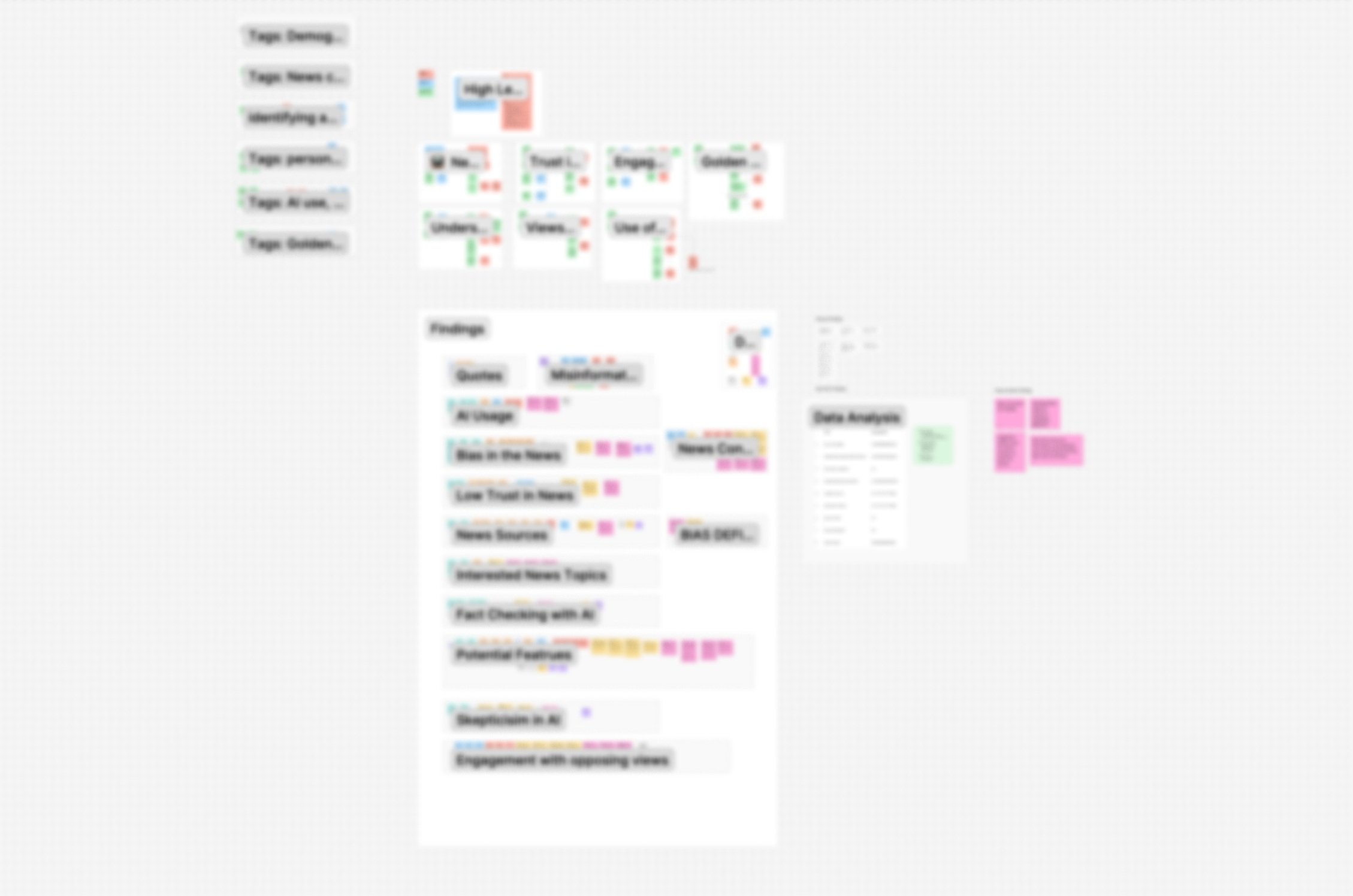Ana: AI News Aggregator
Methods: Rapid Iterative Testing and Evaluation (RITE), user interviews, survey, thematic analysis, inductive coding, affinity diagramming, card sorting, request for proposal (RFP)
Tools: Perplexity, Chat GPT, UX Research, Dovetail, Figma, Figjam, IOS Component Library
Ana is an AI-powered news aggregator designed to detect media bias and support users in accessing factual, balanced news. This mobile app points out biased content and explains its origins while encouraging media literacy through embedded educational content.
Timeline
April 7th 2025–June 9th 2025
Team
Bhavika Arigala, Diego J. Reyes-Alicea, ,
Suleyman Sarigoz, Vedant Darak
Contribution
Empirical research, artifacts, survey/meta analysis, data set analysis
Problem
Most news aggregators show multiple perspectives but don’t help users understand why an article is biased. Our user research showed Gen Z deeply distrusts both mainstream outlets and AI tools that feel opaque.
Goals
Identify user interests and topic preferences.
Develop and refine AI prompts for detecting bias.
Compare AI and user perceptions of bias, especially when exposed to articles with different framing.
Identify the most cognitively disruptive types of media bias for users aged 18–28.
Measure user engagement and trust through participation in rating and flagging mechanisms.
Improve media literacy.
Methods
Competitive Analysis
User Interviews
Survey
Inductive Coding
Affinity Diagram
Card Sorting
In-Class Activity
Request for Proposal
RITE Method
Current UI Design
Single Media Analysis
The primary function is to provide a clear analysis of media inputted into Ana. The output gives details on source credibility, detected biases, perspectives included/omitted and other information to consider. This function was the focus of user testing.
Additional Functions
Users sometimes also explored secondary functions. Future work will include more in-depth testing of secondary features. Here are additional flows that were created.
News For You
Personalized news feed, a function available to account holders.
Discussions
A space where account holders can engage in political dialogue.
Methodology
A database that houses Ana’s AI instructions as well as key definitions.
User Testing
Ana’s current MVP comes from a round of usability testing using the RITE method. The testing was conducted within a week. The usability test focused on the single media analysis flow. Participants were then encouraged to explore the rest of the application.
Participant 1
36, Male, Unemployed
Participant 2
26, Male, Student
Testing Highlights
These are some of the changes made from user 1 test to user 2 test. Users also had a chance to explore additional flows.
✅ Information Hierarchy
Users requested to see the “Main Take aways” immediately, but the initial design buried this content below the scroll.
✅ Interactive Clarity
Key interactive elements, lije the “main Takeaways” button, lacked strong visual cues to show they were clickable
Design Pivot: Lo-Fi to Mid-Fi
Our team traded Requests for Proposal with Her Team (another capstone project team). My team and I found themselves debating over micro design decisions that could easily be solved using a component library. We selected the IOS 18 component library because of its popularity amongst mobile users.
Her Team confirmed that the core concept was strong and the onboarding flow was "smooth and intuitive".
Early Stages: Pre Lo-fi
In order to define what we wanted in the MVP of Ana. We created a user flow chart of various tasks and the functionality of potential pages. Some of the post important flows that were identified included:
Single Media Analysis
News For You
Discussions
Methodology
Account Creation
Methods Used to Create Ana
Competitive Analysis
Ground News offers tools to track media bias and compare coverage across sources. It features a bias checker, bias distribution visuals, and AI-generated summaries. The platform is accessible via desktop, mobile app, website, and Chrome extension.
AllSides emphasizes presenting diverse political and social perspectives. It includes a media bias vote and human-written articles to highlight contrasting viewpoints. However, it lacks AI summaries and in-depth bias comparison tools. It’s available on desktop and mobile.
TIMIO provides bias insights through a checker and comparison features. While it also relies on human-written content, it does not support AI summaries or article reporting.
Ana’s AI System
We prompt engineered a set of custom instructions for the underlying large language model, using Perplexity. This methodology was inspired by scholarly work on quantifying bias, notably from Xiao Fang et al.'s article, "Bias of AI-generated content."
Testing Ana’s AI System
To validate both our AI's output and our hypothesis about the user-AI perception gap, we conducted a "Media Bias Detection Sprint" in class. Following a structured protocol, classmates first analyzed headlines manually and then compared their findings to Ana's generated analysis.
This controlled experiment provided direct, tangible evidence of discrepancies in bias detection, reinforcing the need for a systematic tool like Ana.
Findings
Survey
Subject vs. Perspective
A left-leaning headline critical of the GOP ("These 'performative' GOP 'temper tantrums'...''). A significant 66.7% of participants perceived it as right-leaning, confusing the article's subject (conservatives) with its critical perspective (left-leaning).
Subtle Framing
46.2% of respondents misidentified a right-center headline ("Trump needs unity...") as "Least Biased," suggesting users often miss bias embedded in seemingly neutral language.
Overt Bias
Participants accurately identified headlines with overt, emotionally charged language (e.g., "Busted underground nightclub harboring illegals...") with 51.3% accuracy.
Market Potential
82% of respondents never having used AI news aggregator indicates our product has significant market education potential.

User Interviews
The interviews explored political views, perceptions of bias, and news consumption habits.
Participants expressed deep skepticism toward mainstream and AI-generated news, citing fears of misinformation and algorithmic manipulation. Many called for greater transparency and diverse viewpoints. Our interviews revealed a strong preference for tools that could identify bias, facilitate fact-checking, and present multiple perspectives.
Columns in blue represent the political perspective of the participant (based on U.S. politics).
Thematic Findings
Card Sorting
User interviews conducted with card sorting. This activity gave us an initial idea of the order of in which Ana’s output should be presented.
The order and language was later changed after getting Ana in front of users.
Figma Prototype
Reflection
Ana is a promising step toward a new generation of news tools built on trust and media literacy. By combining AI's analytical power with a deep commitment to user-centered design, this project provides a framework for empowering users to consume news and, more importantly, to understand it critically.
Future Work
🔺
Broader Demographic Testing
Conduct studies with a more politically and demographically diverse user base to ensure Ana is effective for all users .
🚩
Building Interactivity
Implement user-requested flagging and feedback mechanisms to create a “human-in-the-loop” system that refines AI assessments over time, building trust and engagement.
🤖
Enhancing AI Explainability
Develop the AI to provide nuanced explanations for its bias ratings, particularly for complex cases like the subject/perspective confusion we observed.
🖥️
Expanding to Desktop
Ana was designed to be successful as a responsive design, next steps include designing the desktop version.




























